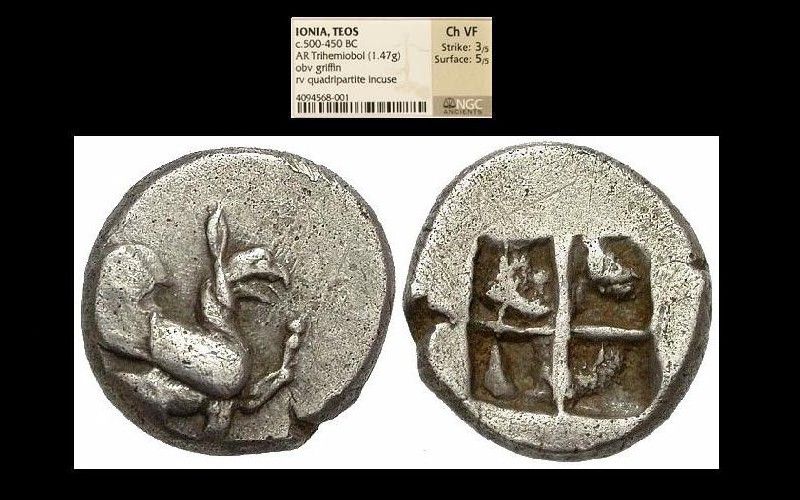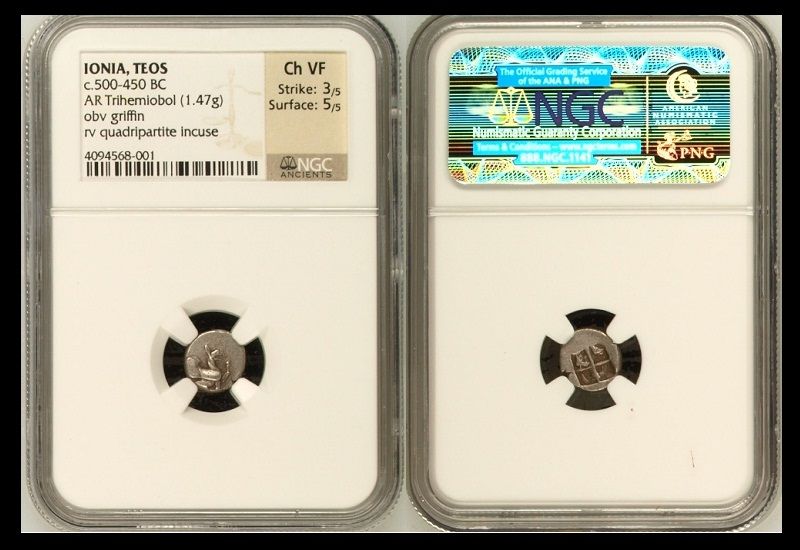Options
Ancient Greece: Ionia, Teos, silver trihemiobol, ca. 510-490 BC
 lordmarcovan
Posts: 43,847 ✭✭✭✭✭
lordmarcovan
Posts: 43,847 ✭✭✭✭✭
Ancient Greece: Ionia, Teos, silver trihemiobol, ca. 510-490 BC.
Obverse- griffin seated right, forepaw raised.
Reverse- quadripartite incuse square, bold partition lines forming cross, irregular shapes within incuse quarters.
NGC Ch VF (Strike 3/5, Surface: 5/5). 10.5 mm, 1.46 g. Ex-FORVM Ancient Coins, 7/18/2012, purchased raw.
NGC went with a wider date range of 500-450 BC, but FORVM was more specific, dating it to ca. 510-490 BC.


Original seller page
NGC cert verification page
Coins of Ionia, Teos (Wildwinds)
Wikipedia links:
Teos
Griffin (griffon, gryphon)
When posted here, this coin was part of my "Eclectic Box of 20" collection.
It later did double duty in my Greek & Roman Provincial collection.
Obverse- griffin seated right, forepaw raised.
Reverse- quadripartite incuse square, bold partition lines forming cross, irregular shapes within incuse quarters.
NGC Ch VF (Strike 3/5, Surface: 5/5). 10.5 mm, 1.46 g. Ex-FORVM Ancient Coins, 7/18/2012, purchased raw.
NGC went with a wider date range of 500-450 BC, but FORVM was more specific, dating it to ca. 510-490 BC.


Original seller page
NGC cert verification page
Coins of Ionia, Teos (Wildwinds)
Wikipedia links:
Teos
Griffin (griffon, gryphon)
When posted here, this coin was part of my "Eclectic Box of 20" collection.
It later did double duty in my Greek & Roman Provincial collection.
0

Comments
WNC Coins, LLC
1987-C Hendersonville Road
Asheville, NC 28803
wnccoins.com
<< <i>Very cool! I've been looking for a good griffin coin as they are one of my favorite mythological beasts as well. I'm wondering what those engravings are supposed to be within the quadripartite incuse punch on the reverse? >>
I've wondered that, too. Plants? Fish? Dunno. Intriguing, though.
These ones are really cool because if I'm not mistaken they are some of the first coin money, yes the electrum slabs with a basic punch are earlier and cool in their own right but these are the first ones with actual designs around 500BC
<< <i>I've been slowly getting into these Greek coins as well as the roman imperial stuff, by getting into I mean learning about them, I haven't pulled the trigger on any pre-roman greek stuff yet but I did get the 100 Greatest Ancient Coins book and I've been reading about them on FORVM and such.
These ones are really cool because if I'm not mistaken they are some of the first coin money, yes the electrum slabs with a basic punch are earlier and cool in their own right but these are the first ones with actual designs around 500BC >>
The 100 Greatest Ancients is a great book. If you want some coins to really salivate over, I suggest the Hunt Collection catalogs - they run $200+ for the entire set but they have some amazing coins pictured with great description. Alternatively, the book "Wealth of the Ancient World" is also fantastic and has some of the same coins pictured (albeit in black and white).
Without trying to hijack the thread, this is my current oldest coin, just prior to 500BC. lordmarcovan's trihemiobol is pure silver whereas this is electrum (Mytilene, the originating city for my coin at this time had a gold content around 43% which made many of the coins look lighter, although this hekte is pretty clearly gold colored):
<< <i>Out of curiosity, lordmarcovan - what was your oldest coin? >>
Maybe this little Miletos (or "Miletus") lion is a bit older than the Teos griffin above?
I just swapped it to Greg Capps ("savoyspecial"). Though tiny (maybe even a little tinier than the Teos above), it was a terrific little piece.
All the more so because I acquired it for the princely sum of 26 dollars in trade (some fossil shark teeth)! The slab cost more than the coin!
I could buy stuff like that all day long.
Speaking of lions, I've seen that one on your electrum piece before, but WOW (as usual) about that piece! I have never seen that rooster head before! It looks incuse, so I guess it was the "punch" side? Not only are your coins mindblowing, but they look great with the "reflective" Photoshop templates, too!
Oh, and I don't mind your "hijacking" my threads at all. Your coins add quite a bit of class, I say.
<< <i>
Maybe this little Miletos (or "Miletus") lion is a bit older than the Teos griffin above?
I just swapped it to Greg Capps ("savoyspecial"). Though tiny (maybe even a little tinier than the Teos above), it was a terrific little piece.
All the more so because I acquired it for the princely sum of 26 dollars in trade (some fossil shark teeth)! The slab cost more than the coin!
I could buy stuff like that all day long. >>
That's a heck of a lot of "cool" for $26!
<< <i>Speaking of lions, I've seen that one on your electrum piece before, but WOW (as usual) about that piece! I have never seen that rooster head before! It looks incuse, so I guess it was the "punch" side? Not only are your coins mindblowing, but they look great with the "reflective" Photoshop templates, too!
You're correct - the rooster reverse is incuse and pretty impressively engraved for a coin this small (it's 2.55g and 10mm). I can't imagine how they managed to do that back then (granted, my artistic abilities, or lack thereof, probably skew my perceptions of what is and is not difficult). I haven't posted it here before - I've fallen behind with getting coins posted - and that reminds me that I need to get on top of taking some new images and posting coins!
<< <i>
Oh, and I don't mind your "hijacking" my threads at all. Your coins add quite a bit of class, I say. >>
Thanks
I'm also amazed that we're seeing this kind of detail on a coin from the 6th century BC that is so tiny
did they have some form of primitive magnifying device?
and then you just watch the quality drop off a cliff from the decline and fall of rome through the "dark ages"
<< <i>very cool pieces guys
I'm also amazed that we're seeing this kind of detail on a coin from the 6th century BC that is so tiny
did they have some form of primitive magnifying device?
and then you just watch the quality drop off a cliff from the decline and fall of rome through the "dark ages" >>
The Greeks in their heyday were the unquestioned masters of die engraving, that is for sure. They weren't equaled again until after the Renaissance, in my opinion, and some would argue that they have never been equaled.
<< <i>That's a heck of a lot of "cool" for $26! >>
That's the beauty of ancients. Anybody can play, on any budget. Of course it takes deep pockets indeed to play in your league, SmEagle1795, but we "little guys" can get a lot of bang for our paltry budgets, too.
So if anybody who's reading this has always been interested in ancients but been afraid to start collecting them because they're perceived to be too expensive, forget that. You can sometimes get late Roman bronze coins for a dollar or less. And for less than $50 or even $20, you can get some really nice stuff- even silver- as some of my other recent threads demonstrate. And of course you do not have to spend $35 a whack entombing them in pricey plastic like I do, either.
Another thing that scares folks away from collecting ancients (I myself fell victim to this for decades) is the intimidation caused by the infinite minutiae and the perception that encyclopedic knowledge is required. It isn't. Step right in. Wildwinds.com, internet forums, and Wikipedia are your friends. Nobody learns everything before they start collecting this stuff, because nobody ever can learn it all, or even a fraction of it. Just step right in.
Welcome to the darkside
<< <i>Still in the learning phase by far, but its a great adventure with no boundaries really. >>
Indeed. And guess what? The "learning phase" never ends, even for "big boys" like our SE1795, there. But that's the fun of it. Things would get stale and boring pretty quickly if there wasn't anything left to learn.
This is perhaps one reason why so many of our Liteside brethren get into die variety minutiae like VAMs and Overton numbers and the Cherrypicker's Guide and so on. It's far easier to "learn the ropes" in a "modern" series* (and ALL US coins are modern by comparison). Once you've done that, there's nowhere to shift your focus but deeper and deeper into the minutiae, until you can't see the forest for the trees and you can't see the trees for the leaves, and you can't see the leaves for their cell structure.
Mind you, there is plenty of minutiae with ancients- at least as much if not more than with US coins- but it's such a vast field that there is all sorts of opportunity to explore new territory, as casually or as deeply as you might wish. (And with new hoards found all the time, "discoveries" come on the market more often.)
I've never been the extreme scholar type, and prefer a more casual and generalistic approach, but I do respect those who are numismatic scholars. (And yes, that respect also extends to the Liteside VAM people and Bust Half Nuts and Cherrypickers I just gently poked fun at.)
*- Our wise Cladking might disagree with this statement.